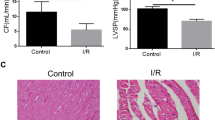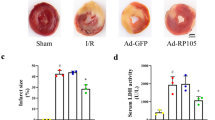Abstract
This study aimed to investigate the role of PPARγ and underlying mechanisms in myocardial ischemia/reperfusion injury (IRI). IRI was surgically induced in mice and neonatal rat cardiomyocytes (NRCM) were exposed to oxygen-glucose deprivation and reoxygenation (OGD/R). Quantitative genetic analysis and western blotting were performed to assess mRNA and protein levels, respectively, of PPARγ, as well as of different inflammatory, fibrosis, and apoptosis markers in cells and tissues. PPARγ was overexpressed in the heart of mice and NRCMs by viral transfection. Apoptosis and fibrosis were detected by TUNEL and Masson’s trichrome staining, respectively. Enzyme-linked immunosorbent assay was performed to detect M1 and M2 macrophage-related inflammatory factors present in mouse sera. PPARγ overexpression significantly inhibited OGD/R- and IRI-induced cardiomyocyte apoptosis and fibrosis in vitro and in vivo. Moreover, PPARγ overexpression inhibited IRI-induced secretion of M1-related proinflammatory factors, whereas it supported the secretion of M2-related anti-inflammatory factors. Notably, these events were found to be mediated by the JAK/STAT pathway. In conclusion, PPARγ regulates macrophage polarization upon IRI via the JAK/STAT pathway, which will in turn prevent myocardial apoptosis and fibrosis. Hence, PPARγ may represent a valuable target for myocardial IRI treatment.






Similar content being viewed by others
Data Availability
The data that support the findings of this study are available from the corresponding author upon reasonable request.
Abbreviations
- IL:
-
interleukin
- IRI:
-
ischemia/reperfusion injury
- NRCM:
-
neonatal rat cardiomyocyte
- OGD/R:
-
oxygen-glucose deprivation and reoxygenation
- PPAR:
-
peroxisome proliferator-activated receptor
- RT-qPCR:
-
Real-time quantitative polymerase chain reaction
- TGF:
-
transforming growth factor.
References
Wu, M. Y. et al. (2018). Current mechanistic concepts in ischemia and reperfusion injury. Cellular Physiology and Biochemistry, 46(4), 1650–1667.
Anaya-Prado, R. et al. (2002). Ischemia/reperfusion injury. Journal of Surgical Research, 105(2), 248–258.
Friedewald, J. J. & Rabb, H. (2004). Inflammatory cells in ischemic acute renal failure. Kidney International, 66(2), 486–491.
Rakhshan, K. et al. (2022). ERK/HIF-1alpha/VEGF pathway: a molecular target of ELABELA (ELA) peptide for attenuating cardiac ischemia-reperfusion injury in rats by promoting angiogenesis. Molecular Biology Reports, 49(11), 10509–10519.
Vinten-Johansen, J. et al. (2007). Inflammation, proinflammatory mediators and myocardial ischemia-reperfusion Injury. Hematology/Oncology Clinics of North America, 21(1), 123–145.
Toldo, S. et al. (2018). Inflammasome, pyroptosis, and cytokines in myocardial ischemia-reperfusion injury. American Journal of Physiology-Heart and Circulatory Physiology, 315(6), H1553–h1568.
Li, H. X. et al. (2018). Inhibition of glycogen synthase kinase-3beta is involved in cardioprotection by alpha7nAChR agonist and limb remote ischemic postconditionings. Bioscience Reports, 38(5), BSR20181315.
Pan, Y. et al. (2019). Single-cell RNA sequencing reveals compartmental remodeling of tumor-infiltrating immune cells induced by anti-CD47 targeting in pancreatic cancer. Journal of Hematology & Oncology, 12(1), 124.
Rao, J. et al. (2020). Nogo-B is a key mediator of hepatic ischemia and reperfusion injury. Redox Biology, 37, 101745.
Khera, R. et al. (2022). Role of JAK-STAT and PPAR-Gamma Signalling modulators in the prevention of autism and neurological dysfunctions. Molecular Neurobiology, 59(6), 3888–3912.
Haraguchi, G. et al. (2008). Pioglitazone reduces systematic inflammation and improves mortality in apolipoprotein E knockout mice with sepsis. Intensive Care Medicine, 34(7), 1304–1312.
Shimazu, T. et al. (2005). A peroxisome proliferator-activated receptor-gamma agonist reduces infarct size in transient but not in permanent ischemia. Stroke, 36(2), 353–359.
Wu, L. et al. (2012). Inhibition of PPARgamma in myeloid-lineage cells induces systemic inflammation, immunosuppression, and tumorigenesis. Blood, 119(1), 115–126.
Cuzzocrea, S. (2004). Peroxisome proliferator-activated receptors gamma ligands and ischemia and reperfusion injury. Vascular Pharmacology, 41(6), 187–195.
Yang, Y. et al. (2013). JAK2/STAT3 activation by melatonin attenuates the mitochondrial oxidative damage induced by myocardial ischemia/reperfusion injury. Journal of Pineal Research, 55(3), 275–286.
Zhang, W. Y., Zhang, Q. L. & Xu, M. J. (2019). Effects of propofol on myocardial ischemia reperfusion injury through inhibiting the JAK/STAT pathway. European Review for Medical and Pharmacological Sciences, 23(14), 6339–6345.
Sharifi, M. et al. (2021). Necroptosis and RhoA/ROCK pathways: molecular targets of Nesfatin-1 in cardioprotection against myocardial ischemia/reperfusion injury in a rat model. Molecular Biology Reports, 48(3), 2507–2518.
Naseroleslami, M. et al. (2022). Simvastatin-loaded nano-niosomes efficiently downregulates the MAPK-NF-kappaB pathway during the acute phase of myocardial ischemia-reperfusion injury. Molecular Biology Reports, 49(11), 10377–10385.
Hausenloy, D. J. & Yellon, D. M. (2013). Myocardial ischemia-reperfusion injury: a neglected therapeutic target. Journal of Clinical Investigation, 123(1), 92–100.
Wang, L. et al. (2018). MicroRNAs in heart and circulation during physical exercise. Journal of Sport and Health Science, 7(4), 433–441.
Takahashi, M. (2011). Role of the inflammasome in myocardial infarction. Trends in Cardiovascular Medicine, 21(2), 37–41.
Swirski, F. K., & Nahrendorf, M. (2013). Leukocyte behavior in atherosclerosis, myocardial infarction, and heart failure. Science, 339(6116), 161–166.
Ju, Z. et al. (2020). Anti-inflammatory effects of an optimized PPAR-gamma agonist via NF-kappaB pathway inhibition. Bioorganic Chemistry, 96, 103611 p.
Hattori, R. et al. (2001). Role of STAT3 in ischemic preconditioning. Journal of Molecular and Cellular Cardiology, 33(11), 1929–1936.
Jin, L. et al. (2020). Ghrelin inhibits inflammatory response and apoptosis of myocardial injury in septic rats through JAK/STAT signaling pathway. European Review for Medical and Pharmacological Sciences, 24(22), 11740–11746.
Xu, M., Li, X. & Song, L. (2020). Baicalin regulates macrophages polarization and alleviates myocardial ischaemia/reperfusion injury via inhibiting JAK/STAT pathway. Pharmaceutical Biology, 58(1), 655–663.
Wynn, T. A., & Vannella, K. M. (2016). Macrophages in tissue repair, regeneration, and fibrosis. Immunity, 44(3), 450–462.
de Couto, G. et al. (2015). Macrophages mediate cardioprotective cellular postconditioning in acute myocardial infarction. Journal of Clinical Investigation, 125(8), 3147–3162.
Saini, H. K. et al. (2005). Role of tumour necrosis factor-alpha and other cytokines in ischemia-reperfusion-induced injury in the heart. Experimental & Clinical Cardiology, 10(4), 213–222.
Bolli, R., Dawn, B. & Xuan, Y. T. (2001). Emerging role of the JAK-STAT pathway as a mechanism of protection against ischemia/reperfusion injury. Journal of Molecular and Cellular Cardiology, 33(11), 1893–1896.
Chen, X. et al. (2020). beta-Arrestin-2 attenuates hepatic ischemia-reperfusion injury by activating PI3K/Akt signaling. Aging (Albany NY), 13(2), 2251–2263.
Liu, X. et al. (2019). Ticagrelor reduces ischemia-reperfusion injury through the NF-kappaB-dependent pathway in rats. Journal of Molecular and Cellular Cardiology, 74(1), 13–19.
Fawzy, M. A. et al. (2021). Pantoprazole attenuates MAPK (ERK1/2, JNK, p38)-NF-kappaB and apoptosis signaling pathways after renal ischemia/reperfusion injury in rats. International Journal of Molecular Sciences, 22(19), 10669.
Xue, S. et al. (2018). Hypothermic machine perfusion attenuates ischemia/reperfusion injury against rat livers donated after cardiac death by activating the Keap1/Nrf2ARE signaling pathway. Molecular Medicine Reports, 18(1), 815–826.
Stephanou, A. (2004). Role of STAT-1 and STAT-3 in ischaemia/reperfusion injury. Journal of Cellular and Molecular Medicine, 8(4), 519–525.
Oh, Y. B. et al. (2013). Inhibition of Janus activated kinase-3 protects against myocardial ischemia and reperfusion injury in mice. Experimental & Molecular Medicine, 45, e23.
Huang, X. P. et al. (2015). Effects of the combination of the main active components of astragalus and panax notoginseng on inflammation and apoptosis of nerve cell after cerebral ischemia-reperfusion. American Journal of Chinese Medicine, 43(7), 1419–1438.
Fridman, J. S. et al. (2010). Selective inhibition of JAK1 and JAK2 is efficacious in rodent models of arthritis: preclinical characterization of INCB028050. Journal of Immunology, 184(9), 5298–5307.
Hilbert, T. et al. (2018). Synthetic CpG oligonucleotides induce a genetic profile ameliorating murine myocardial I/R injury. Journal of Cellular and Molecular Medicine, 22(7), 3397–3407.
Funding
This work was supported by the Startup Fund for Scientific Research, Fujian Medical University (Grant number: 2021QH1125) and the Research Project of Young and Middle-aged Teachers of Fujian Provincial Department of Education (Grant number: No. JAT200111).
Author information
Authors and Affiliations
Contributions
S.W. performed the experiments and data analysis. Y.C. and R.B. conceived and designed the study. Y.W. and Q.L. made the acquisition of data. Y.C. and C.W. found resources required. All authors read and approved the manuscript.
Corresponding author
Ethics declarations
Conflict of Interest
The authors declare no competing interests.
Additional information
Publisher’s note Springer Nature remains neutral with regard to jurisdictional claims in published maps and institutional affiliations.
Rights and permissions
Springer Nature or its licensor (e.g. a society or other partner) holds exclusive rights to this article under a publishing agreement with the author(s) or other rightsholder(s); author self-archiving of the accepted manuscript version of this article is solely governed by the terms of such publishing agreement and applicable law.
About this article
Cite this article
Wang, S., Cai, Y., Bu, R. et al. PPARγ Regulates Macrophage Polarization by Inhibiting the JAK/STAT Pathway and Attenuates Myocardial Ischemia/Reperfusion Injury In Vivo. Cell Biochem Biophys 81, 349–358 (2023). https://doi.org/10.1007/s12013-023-01137-0
Received:
Accepted:
Published:
Issue Date:
DOI: https://doi.org/10.1007/s12013-023-01137-0




